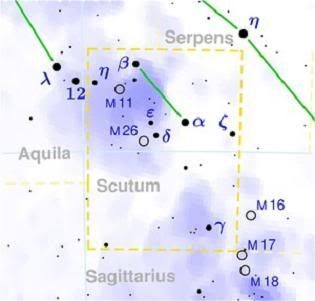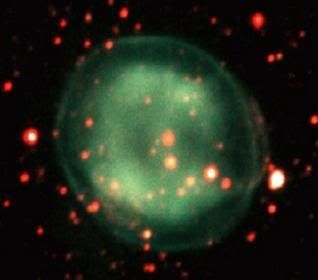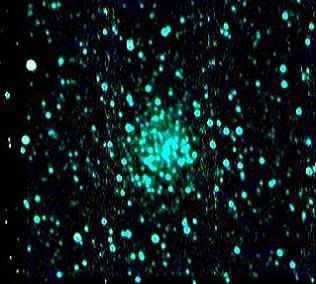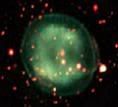Post by glactus on Feb 17, 2008 5:35:22 GMT

The constellation of Scutum is being counted to the Hercules constellation family. Although it is one of the smallest constellations (in fact the 5th smallest), it is located in a very interesting part of the sky because, next to the Milky Way, it contains rich Milky Way star fields and therefore is also of interest for the amateur astronomer. Scutum can be found southwest from Ophiuchus and southeast from Aquila, the Eagle, just ten degrees south of the celestial equator.
Notable stars:
Alpha Scuti
á Scuti is a fourth-magnitude star occasionally called by the traditional Greek name Ionnina or Ioannina, which literally means "Of John". It is an orange K-type known variable giant with an apparent magnitude of 3.85. Distance is approximately 174 light years from Earth.
Delta Scuti
d Scuti is the prototype of a rare class of variable stars undergoing small pulsations within the range of a few hours. This leads to minor changes in the brightness of the star. The variation have a period of 4h 40min during which the brightness varies from 4.6 mag to 4.7 mag. Distance from Earth is 187 light years.
R Scuti
r Scuti is a member of the still-mysterious class of "RV Tauri stars," which are pulsating variables. Unlike Cepheids, they have low masses in spite of their distended natures. Their evolutionary status is unclear, but the feeling is that they have already done with their giant or supergiant behavior, and with dead carbon-oxygen cores, are in a state of transition in which they will possibly turn into planetary nebulae and become white dwarfs. Magnitude varies between 5th and 8th, and the distance from Earth is 1,400 light years.
Epsilon Scuti
e Scuti is a star system approximately 523 light years from Earth. The primary component, Epsilon Scuti a, is a yellow G-type bright giant with an apparent magnitude of 4.88. It has at least three faint companions, two 14th magnitude stars, b, and d, separated from the primary by 13.6 and 15.4 arcseconds respectively, and the 13th magnitude c, which is 38 arcseconds away.
Notable objects:

IC 1295
IC 1295 is a real show stopper if you can find it. Although faintish, this planetary nebula can be glimpsted even with a 70mm telescope. UHC filter is helpful. Magnitude is 15.1 and distance from Earth is 3,600 light years.

Messier M11
The Wild Duck is an open cluster discovered by Gottfried Kirch in 1681. Charles Messier included it in his catalogue in 1764. M 11 is one of the richest and most compact of the known open clusters, containing about 2900 stars. Its age has been estimated to about 220 million years. The name derives from the brighter stars forming a triangle which could represent a flying flock of ducks. Magnitude is 6.3 and distance from Earth is 6,200 light years.

NGC 6712
NGC 6712 is a globular cluster that was probably discovered by Le Gentil on July 9, 1749 when investigating the Milky Way star cloud in Aquila. John Herschel was the first to described it as a globular star cluster during his observations in the 1830s. Magnitude is 8.69 and distance from Earth is 22,500 light years.

IC 1295
credits:
Scutum map: Wikipedia
en.wikipedia.org/wiki/Scutum
image: IC 1295: gabinete
www.iac.es/gabinete/difus/ruta/n1.htm
image: Messier M 11: noao
www.noao.edu/image_gallery/images/d5/m11a.jpg
image: NGC 6712: Koski
www.ursa.fi/~koski/deepsky/gc2.html


